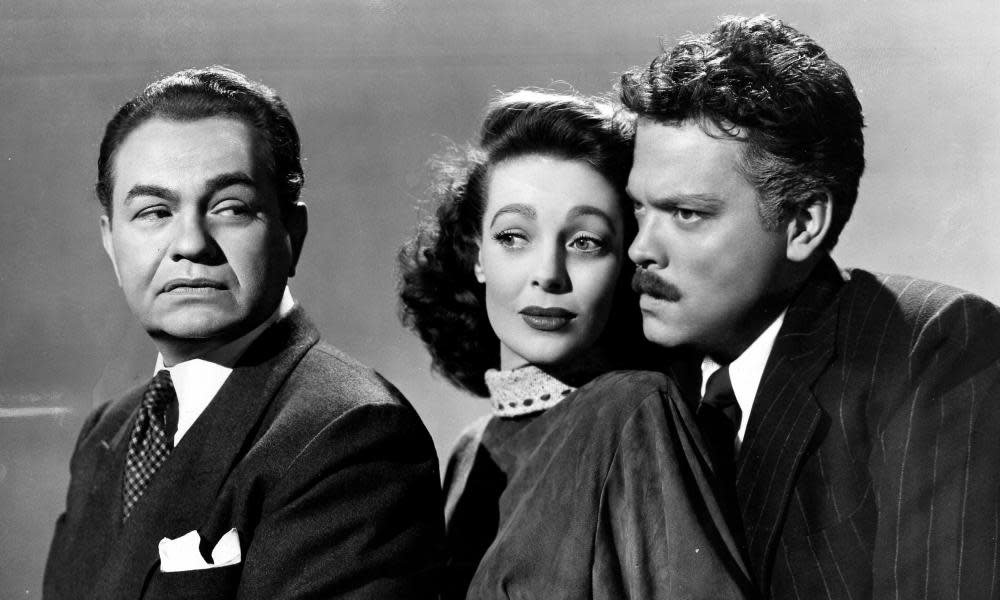My streaming gem: why you should watch The Stranger

In these lockdown times, we should all be scrambling to watch films that will help us to make sense of our out-of-life experience, no? Pandemic thrillers, online horrors, dystopian sci fi – these can all teach us what we need to know, right?
Related: My streaming gem: why you should watch The Killing of America
Maybe, maybe not. When the real-life news is vastly more consequential than anything the cinema can cook up, surely it is time to dive into the past. Nothing bad ever happened then, did it? As it turns out, the wastelands of pre-1970 Netflix mean there’s little material to go on. I would have tried My Man Godfrey if Pamela Hutchinson hadn’t got there first. But what’s this? Not one, but two brilliant Edward G Robinson film noirs from his late-1940s golden period: The Stranger and The Woman in the Window. This was when Robinson was at the top of his game, exuding a world-weary righteousness in Double Indemnity and playing the sap in a pair of outstanding Fritz Lang tragedies, of which Woman in the Window is one. (The other, Scarlet Street, was a remake of Jean Renoir’s first film, La Chienne.)
The Stranger, perhaps, is the more interesting film, and ties into Robinson’s own off-screen life. Though his beaten-up mug was to be seen numerous times in the first part of his acting career as a hoodlum or villain – most notoriously in Little Caesar, the 1931 role that put him on the map – Robinson was in fact a sensitive, art-collecting, anti-fascist of the old school, whose family escaped antisemitic riots in Romania, sailing to New York when Robinson (then plain Manny Goldenberg) was 10 years old. He donated a quarter of a million of 1940s dollars to charitable causes during and after the second world war, and even though he aired his disgust of communism as he named names at the Huac hearings, had his career derailed in the 1950s by an unofficial political “greylisting”.
In The Stranger he distils all that in his role as UN investigator Wilson, working a complicated bait-and-switch by releasing a Nazi minion called Meineke, in the hope that he will lead him to the big fish: Franz Kindler, who is posited by the film as the designer of the final solution – “the most brilliant of the younger minds of the Nazi party … who conceived the theory of genocide”. Kindler, of course, is played by Orson Welles, rather more plausible (if we are being honest) as the raffish schoolteacher Kindler is aiming to pass himself off as than an Eichmannesque architect of the death of millions.
Another part of The Stranger’s allure is that it’s a pit-stop in Welles’s relatively brief Hollywood career, an attempt to rebuild his profile after the savaging that RKO had inflicted on The Magnificent Ambersons. It was his third credited directing job (though purists might also include Journey into Fear) and appears to suggest Welles was in relatively contrite mode, trying to prove he could make a straightforward studio picture on time and on budget. Well, as it turned out, The Stranger is the closest Welles ever got to a bona fide commercial hit (to paraphrase Alan Partridge, it was only the film Citizen Kane could have been). Reports suggest that Welles was largely powerless in the face of Universal’s “supercutter” Ernest Nims, the studio editor who Welles described as his “nemesis”.
Well, even so, The Stranger has a lot of great stuff in it, from the down-home checkers obsessively manning the till at the local cafe, to the gloriously shadowy photography courtesy of Russell Metty (who would work on Welles’s even more extravagant Touch of Evil a decade later). Welles even contrives a suitably noir-gimmick ending, atop a very rickety ladder, where Kindler is stabbed to death by the moving figure of a Teutonic-looking medieval swordsman on his beloved clock. (Oh, the irony.) The rather sketchy nature of what Kindler is accused of shows that the grim details of the Holocaust had yet to percolate very far into American culture, though Welles did make a point of including a brief series of vérité documentary shots of concentration camps to provide what would now be called a teachable moment.
However, The Stranger, principally, brings home the enduring theme of noir: the devastation that the second world war wreaked on the American psyche, and the silent nastiness that proliferated behind the white picket fence. (Nothing new, of course, if you were African American or First Nation.) Unearthing a war criminal as he marries into the family of a supreme court justice is a fairly uncomplicated deployment of the motif – but in these dislocated times it’s a reminder that once the American establishment took exception to Nazis. Somehow that seems a long time ago.
The Stranger is available on Amazon Prime and Netflix in the UK and US

 Yahoo Movies
Yahoo Movies 
